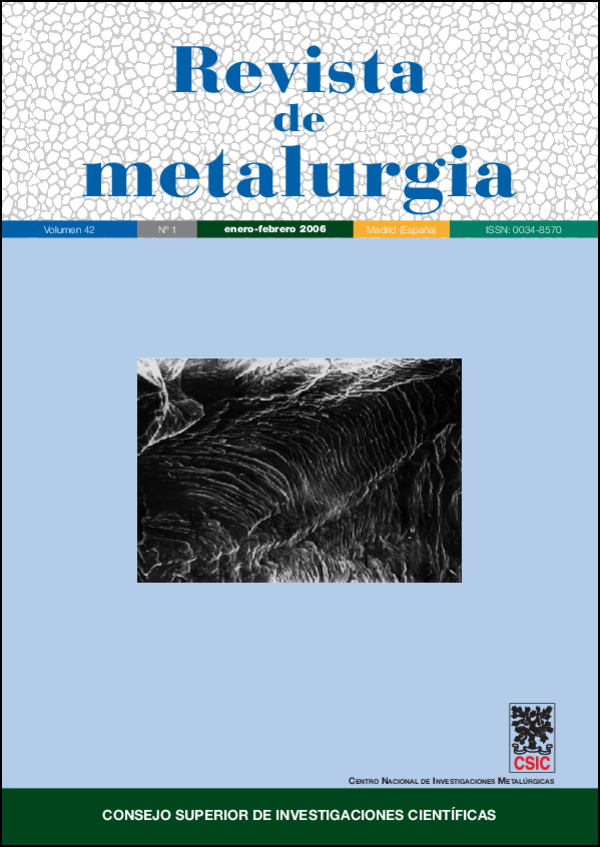Ni, Co recovery study and Fe by acid leaching in columns
DOI:
https://doi.org/10.3989/revmetalm.2006.v42.i1.5Keywords:
Leaching, Sulfuric acid, Percolation, Nickel, CobaltAbstract
In the following work the possibility of the nickel recovery by hydrometallurgy extraction for nickeliferous laterites is studied. The work looks for to study the technical viability of the extraction of nickel and cobalt by means of the application of heap leaching. The ore is chemically and physically characterized with the purpose of analyzes its composition and mineral phase, by means of x-rays diffraction, quantitative chemical analysis and elementary chemical analysis by electronic microscopy. Once the ore is characterized, it is mixed with sulfuric acid to relations 0.05; 0.1 and 0.2 g acid/g to agglomerated pellets and paste, with the aim to improve the percolation in column, due to the argillaceous nature of the ore leaching rate ranged from 0.305 to 1.06 x10 l/h*m2 and in the agglomerate condition of the percolation l/h*m2 improves at interval 3.05 to 6.11 x10 l/h*m2. Additionally the agglomerate ones are roasted with the purpose of consolidating them and chemically preparing the ore so that it is susceptible to the leaching, by means of oxides sulphation of the ore to high temperatures. This ore preparation is subject under diverse leaching tests like: dynamic tests and columns tests. The dynamic tests were made for different relations solid-liquid from 0.05 from 0.5 x103 g/l, different concentrations of the leaching solution and different reaction times from 24 to 168 h. As far as the columns tests showed, the variables studied were acid/ore mixture ratio, continuity of the leaching irrigation, reusability of the liquor of leaching and roasted temperature which was done from 673, 873 and 1023 K. With these tests times selectivity for nickel and cobalt versus iron were found, obtaining recovery 17 more times nickel than iron and up to 26 more times cobalt than iron and with an high process speed, where most of the recovery is made in the first 24 h.
Downloads
References
[1] Proc.Nickel-Cobalt 97 Int.Symp. – Volumen I, Susbury, Ontario, Canada, 1997, p. 406.
[2] AME Mineral Economics. Nickel, 2001.
[3] M.H. Canon, Fundamentals and practical factors in ammonia. Vol. JMetls, New Cork, USA, 1950, p.67.
[4] A. De La Cuadra, Nueva tendencia en los procesos de obtención de Metales, Guayaquil, Ecuador, 1995 p. 243.
[5] V. Opratko Y J. E. Bell, Canadian patent 922903, (1970).
[6] R. Gomez, S Miranda, Rev. Latinoam. Metal. Mater. 4 (1984).
[7] B. B. Kar, Y. V. Swamy, Trans.Inst. Min. Metall. C (2001).
[8] D. H. Rubision Y V. G. Papangelakis, Hydrometallurgy 58 (2000) 13-26. doi:10.1016/S0304-386X(00)00093-1
[9] D. H. Rubision Y V. G. Papangelakis, Hydrometallurgy 58 (2000) 1-11. doi:10.1016/S0304-386X(00)00094-3
[10] O. Herreros, G. Fuentes, R. Quiroz Y J. Viñals, Rev. Metal. Madrid, 39 (2002) 90-98.
[11] Mc Clelland Y Pool, Bur.Min. (1983).
[12] O. Coto Y D Blas, Curso Perspectivas y desafíos de la biotecnología en la industria minera- metalúrgica, Caracas, Venezuela, 2002.
[13] O´Kane Consultants Inc., Demonstration of application of unsaturated zone hydrology for heap leach optimization. (2000).
[14] H. Sohn Y M. WADSWORTH, Cinética de los proceso de la metalurgia extractiva. Editorial Trillas, 1986, p. 545.
Downloads
Published
How to Cite
Issue
Section
License
Copyright (c) 2006 Consejo Superior de Investigaciones Científicas (CSIC)

This work is licensed under a Creative Commons Attribution 4.0 International License.
© CSIC. Manuscripts published in both the printed and online versions of this Journal are the property of Consejo Superior de Investigaciones Científicas, and quoting this source is a requirement for any partial or full reproduction.
All contents of this electronic edition, except where otherwise noted, are distributed under a “Creative Commons Attribution 4.0 International” (CC BY 4.0) License. You may read the basic information and the legal text of the license. The indication of the CC BY 4.0 License must be expressly stated in this way when necessary.
Self-archiving in repositories, personal webpages or similar, of any version other than the published by the Editor, is not allowed.
















